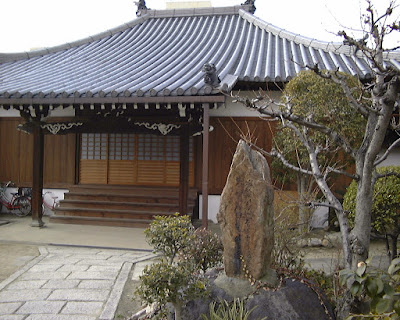Haiku Travels
chrysanthemum scent -
in Nara, ancient statues
of the Buddha
kiku no ka ya | Nara ni wa furuki | hotoketachi
菊の香や奈良には古き仏たち
Basho

In 1694, just before he fell ill and died in Osaka, Basho spent one night in Nara. That was on the ninth day of the ninth month, 1694, the day the Choyo no Sekku or Chrysanthemum Festival was celebrated (our October 27). He wrote this haiku while taking a rest in Shonenji temple and one imagines that the temple grounds were filled with chrysanthemums. The haiku wonderfully catches the atmosphere of Japan's ancient capital, it is as if all these Buddha statues are our old friends.
As the capital of Japan in the 8th c. when Buddhism flourished as a state religion, Nara was (and is) known for its many old temples and wonderful statues of Buddhas, Bodhisattvas and other figures from the Buddhist pantheon, a true treasury of religious art.
"Kiku" is a kigo for autumn; "hotoketachi" is a vernacular haikai phrase.
"The chrysanthemum, considered the aristocrat of flowers in classical poetry, possessed a strong but refined fragrance. The many Buddhas in the ancient capital of Nara evoke a similar sense of dignity, solemnity and refinement, as well as nostalgia for a bygone era." (Shirane, Traces of Dreams, p. 90)

[Chrysanthemum festival in Nihonmatsu]
In fact, one only comes to this temple to see the Basho haiku, inscribed on a stone in front of the small temple hall. The haiku stone is old: it was put up in 1793, to commemorate that already one century had passed since the demise of the haiku master.

[Deer near the Kasuga shrine]
sadly drawn out
deer at night
bii to naku | shirigoe kanashi | yoru no shika
ぴいと啼く尻声悲し夜の鹿
Nara's deer are considered the messengers of the main deity of the Kasuga Shrine, Takemikazuchi, who came riding a deer all the way from Kashima in present-day Ibaraki Prefecture to Nara. At the same time, they remind us of the Deer Park in Benares, where the Buddha gave his first sermon. They therefore have both a Shinto and Buddhist meaning and admirably fit the religious multiplex of Kofukuji Temple and Kasuga Taisha shrine which originally stood here. There are about 1,000 of them and they have always been a protected species. In the past, people who killed one of these animals received the death sentence by being buried alive; now offenders are punished in a somewhat lighter manner. It seems, unfortunately, that this protection has rather spoiled the deer, who have lost their natural meekness and have become positively aggressive. They have been observed to snatch and consume handbags of innocent visitors.
At night the deer are gathered in an enclosure lying to the side of the path leading to the Kasuga Shrine. A trumpet signal calls them together. To prevent them from getting into fights in rut time, their antlers are cut every year from the middle of October to early November. This is done in a special ceremony on Sundays and holidays in that period and attracts many spectators.
On the 8th day of the 9th month in 1694 (so just before his visit to Shonenji) Basho, accompanied by three disciples, took an evening walk near Sarusawa pond and heard the melancholy call of the deer in the distance. Autumn is rut time, when the deer let their cry resound through the forest. These cries in fact vary from a short presence cry, to a long and sad languishing cry (as in the haiku), a defiance cry on a high note, a pursuit cry (when the buck runs behind the doe) and triumph cry. To hear the languishing, melancholy cry in the forest, while around you the shadows are falling, can impart a feeling of deep loneliness, especially when you are a traveler.

[Chrysanthemum festival in Zenkoji, Nagano]
First Haiku:
The haiku stone stands in front of the main hall of Shonenji temple. One can freely enter the grounds to see the haiku stone; the temple hall itself is closed.
20-min walk from Nara Kintetsu Station or JR Nara station
Second Haiku:
The haiku stone stands in front of the deer enclosure to the right side of the path leading to the Kasuga Taisha Shrine. This is where the deer are gathered at night and where the ceremony of cutting the antlers takes place.
30-min. walk from Kintetsu Nara Station. Or bus from JR or Kintetsu Nara Stations to Kasuga Taisha Honden bus stop. The place where the haiku stone stands is always freely accessible.
Translations and Studies of Basho
Basho's Haiku, 2 vols, by Toshiharu Oseko (1990 & 1996, Maruzen): Basho and his Interpreters, Selected Hokku with Commentary, by Makoto Ueda (1992, Stanford U.P.); Traces of Dreams, Landscape, Cultural Memory, and the Poetry of Basho, by Haruo Shirane (1998, Stanford U.P.); Basho's Narrow Road, by Hiroaki Sato (1996, Stone Bridge Press); Basho's Journey, The Literary Prose of Matsuo Basho, by David Landis Bamhill (2005, State University of New York); Basho Yamatoji by Daiyasu Takashi considers Basho's travels in the Nara area and the haiku he wrote there (Izumi Shobo, 1994)
[The photos in this post are my own]
